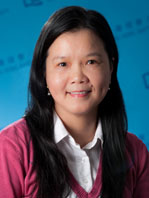Equipping Students to Succeed in the Global World
By Tiffany Ko
“We have to equip our students earlier since they are all global citizens by nature” Professor Siu Yin Cheung said.
To Professor Cheung, our HKBU-affiliated member, the task of a teacher in an interconnected world is not simply preparing students to fit in with the global world but, more importantly, empowering them to stand out from fellow global citizens. To this end, we are delighted to share with you several good practices adopted by Professor Cheung to advance global citizenship training in her classroom. As you read along, you will also see how these transferrable micro-interventions support the teacher to internationalise teaching and learning in Sport and Physical Education at a macro level.
Mindful Grouping
Global citizen is one who can “solve problems, make decisions, think critically, communicate ideas effectively and work well within teams and groups” (Oxfam, 2015). To train future leaders as such, group assignment has not only been made a norm in higher education over the past decade but also used increasingly as a trusted agent to develop students’ intercultural competence in a diverse classroom. It is, on one hand, reasonable for teachers to leverage diversity by putting students into mixed groups for projects. Experience obtained from teachers’ and students’ interviews, on the other hand, reminded us that local and non-local students do not normally like to be “forced” into a team due to their essential differences in language and working style. At the crossroads, the grouping strategy of Professor Cheung might appear as a way-out.
In the course “Leadership and Communication in Sport and Recreation”, it has been the teacher’s practice to engage students in designing and delivering sport or recreation service in groups for the local community. Students were asked to follow some guidelines in grouping. Each group should include students of different gender, backgrounds (such as having a sport-team athlete), as well as various learning styles and academic strengths. Through applying such interventions, the teacher seeks to enable a more balanced thinking and working pattern in the groups. Students with different levels of learning motivation have the opportunity to learn from each other and to develop a flexible mindset. Putting the strategy into the context of internationalisation, the teacher noted that it could blend students of different backgrounds in classrooms of different cultural composition a relatively unmarked manner.
The teacher also created a challenging yet significant approach to maximising students’ take away from the collaborative learning experience. Students were required to report individually “who they consider as the best member of the team” coupled with explanations. The “best member” would get one bonus point if he/she got over 50% votes from the group. Having adopted such peer assessment in various courses over years, Professor Cheung underlined that it is not merely a measure to motivate students. It serves, more significantly, to let student expose to, cope with, and reflect on different working styles stemming from different cultures and walks of life to their max.
E-Portfolio Building
Just as a track record defines the achievement of an athlete, Professor Cheung recognises how a good documentation of learning outcomes matters to the career development of students in the global market. Upon completing the aforementioned community service, the teacher would ask each student to submit an e-Portfolio with the following information: a self-introduction, details of the service, what and how leadership theories were applied in the service, what generic skills the students acquired through the service-learning experience.
To elaborate, all reflections had to come with photos and video(s). Instead of having a self-introduction in text, the students were motivated to tape a 3-minute video pitch to accentuate their strengths under the guidance of teacher partners from the University’s Language Centre. Considering the Department of Sport and Physical Education of HKBU has made overseas internships compulsory to all undergraduates at the turn of this academic year, Professor Cheung also hinted that the e-Portfolio assignment just happened to make their worldwide hunts for internships more efficient and effective, enabling two birds to be killed with one stone.
Changing Students’ Mindset
Nothing is probably comparable to the first-hand experience of studying or having an internship abroad when it comes to developing a sense of how the world works and one’s own position in it. Yet Professor Cheung reminded that undergraduates nowadays risked overlooking the distinct value of these overseas attachment opportunities as they enjoy greater accessibility to “the outside world” via convenient transport and the Internet. The teacher articulated, “our challenge is to convince them why our overseas programmes are more meaningful and worthy of money that could be spent otherwise”. In this regard, the teacher practises what she preaches by sharing her own encounters as an exchange student while also inviting alumni who had been inspired by study-abroad experience for sharing.
To summarise the good practices of Professor Cheung, what she has been doing—making a bit more interventions in grouping, systematically managing students’ learning outcomes, persuading students to learn abroad—are not rocket-science in the internationalisation of teaching and learning. These small moves, however, have jointly formulated the backbone to leverage classroom diversity and support students’ mobility in a natural and practical manner, which aim to equip students with the skills and the mind to embrace global challenges.
Acknowledgments
The editor’s pick draws on an interview with Professor Siu Yin Cheung who generously shared with us her experiences and insights, and we hope we have done justice to the wisdom of her practice in the internationalisation of teaching and learning.
Reference
Oxfam (2015). Global Citizenship in the Classroom: A Guide for Teachers. Oxford, UK: Oxfam Education and Youth.

Cite this item
Ko, T. (2019, May). Equipping Students to Succeed in the Global World. CoP – ITL Buzz, 6. Retrieved from https://www.cetl.hku.hk/cop-itl/whats-happening/enewsletters/issue-06/equipping-students-to-succeed-in-the-global-world/.

